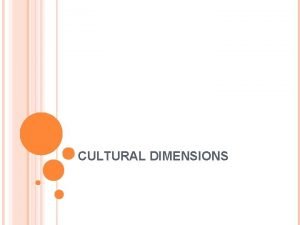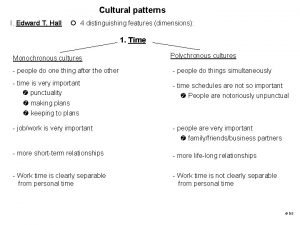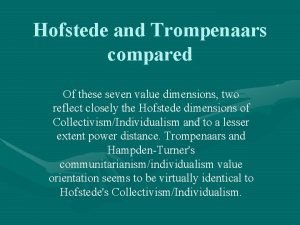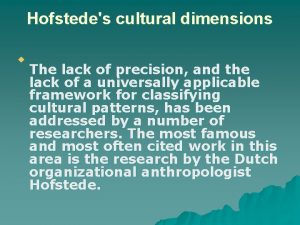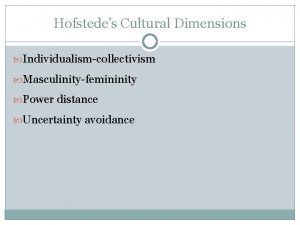Hofstedes cultural dimensions u u u The lack








- Slides: 8


Hofstede's cultural dimensions u u u The lack of precision, and the lack of a universally applicable framework for classifying cultural patterns, has been addressed by a number of researchers. The most famous and most often cited work in this area is the research by the Dutch organizational anthropologist Hofstede derived his culture dimensions from examining workrelated values in employees of IBM during the 1970 s. In his original work he divides culture into four dimensions at culture-level: 1)power distance, 2)individualism /collectivism, 3)masculinity/femininity and 4)uncertainty avoidance.

Power distance u u Power distance is defined as "the extent to which the less powerful members of institutions and organizations within a country expect and accept that power is distributed unequally". (Hofstede, 1994, p. 28) The power distance concept is clearly more far-reaching than the work place alone. Power distance is often reflected in the hierarchical organization of companies, the respect that is expected to be shown by the student towards her or his teacher, the political forms of decentralization and centralization, by the belief in society that inequalities among people should be minimized, or that they are expected and desired. In high power distance countries, India, Mexico, Brazil, employees accept that the boss must be obeyed. In low power distance countries, US, Australia, Denmark, boss gain the trust of employees.

Individualism/Collectivism u u u The concept is one of the most frequently discussed and researched concepts. Hofstede defines this dimension as: "individualism pertains to societies in which the ties between individuals are loose: everyone is expected to look after himself or herself and his or her immediate family. Collectivism as its opposite pertains to societies in which people from birth onwards are integrated into strong, cohesive in-groups, which throughout people's lifetime continue to protect them in exchange for unquestioning loyalty. " (Hofstede, 1994, p. 51) Collectivism is when people see themselves primarily as members of groups. The US has an individualistic culture, Japan has a collectivist culture.

Masculinity/femininity u u u • Masculinity/femininity is an equally powerful, yet often understated, dimension. Hofstede defines this dimension as follows: "masculinity pertains to societies in which social gender roles are clearly distinct (i. e. , men are supposed to be assertive, tough, and focused on material success whereas women are supposed to be more modest, tender, and concerned with the quality of life); femininity pertains to societies in which social gender roles overlap (i. e. , both men and women are supposed be modest, tender, and concerned with the quality of life). " (Hofstede, 1994, p. 823) High masculinity: Japan, Mexico, Italy. High femininity: Norway, Finland, Sweden

Uncertainty Avoidance u u Uncertainty avoidance is the final dimension present in Hofstede's original work. Hofstede defines uncertainty avoidance as "the extent to which the members of a culture feel threatened by uncertain or unknown situations. " (Hofstede, 1994, p. 113) High uncertainy avoidance cultures have strict laws, are highly formal and intolerant. High: Japan, Argentina, Italy, Israel Low: US, Great Britain, Sweden, Denmark. This dimension is fairly easily grasped, and can often be seen reflected in business negotiations.


u The work of Hofstede is probably the most popular work in the arena of culture research. Although the work provides a relatively general framework for analysis, the framework can be applied easily to many everyday intercultural encounters. It is particularly useful, as it reduces the complexities of culture and its interactions into five relatively easily understood cultural dimensions. From: Stephan Dahl: An Overview of Intercultural Research





